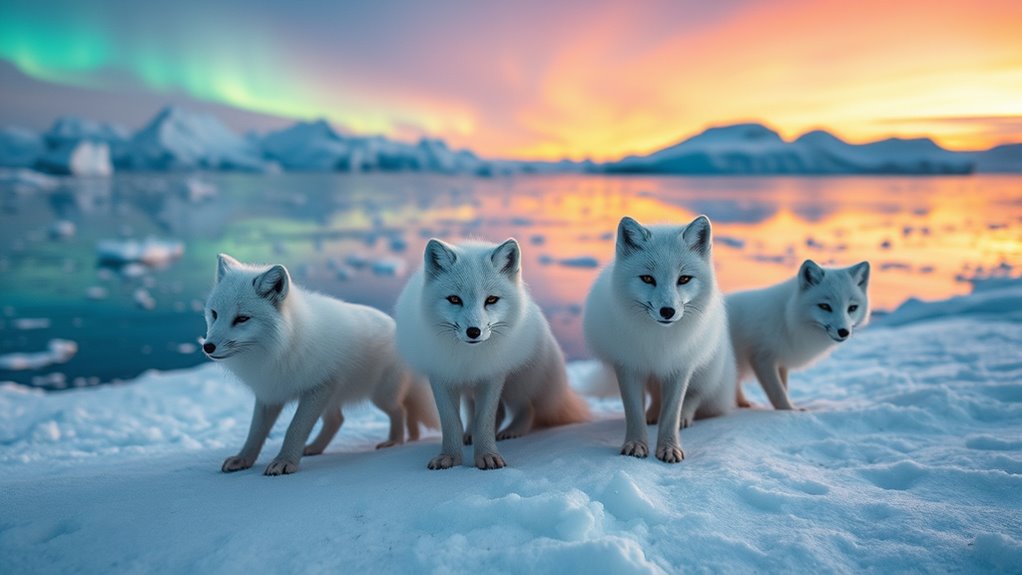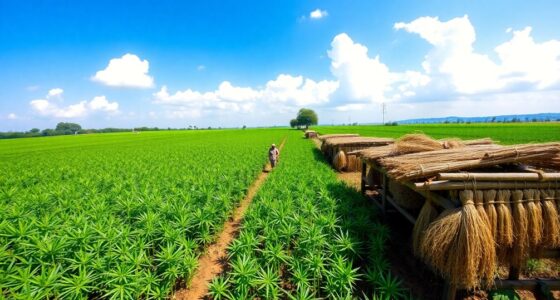Climate change is pushing animals to evolve faster than ever before. As temperatures rise and habitats shift quickly, species need to adapt genetically or risk extinction. Phenotypic plasticity allows individuals to change behaviors temporarily, buying time for longer-term genetic changes. When plastic responses aren’t enough, faster genetic evolution becomes essential. If you’re curious about how these mechanisms interact and what it means for conservation, keep exploring—you’ll discover even more behind the science.
Key Takeaways
- Rapid environmental changes are pushing species to develop beneficial genetic variants within fewer generations.
- Phenotypic plasticity enables immediate behavioral and physical adjustments, aiding survival amid swift climate shifts.
- The combination of plasticity and genetic adaptation accelerates evolutionary responses to environmental stressors.
- Limited plasticity can hinder survival, making rapid genetic evolution essential under extreme climate conditions.
- Higher genetic diversity in populations enhances their capacity for quick adaptation to ongoing climate-driven changes.

Climate change is rapidly transforming the environment, forcing animals to adapt or face extinction. As temperatures rise and habitats shift unpredictably, species are pushed to evolve at an unprecedented pace. You might think evolution takes thousands of years, but recent research shows that animals are now adapting within just a few generations. One way they do this is through genetic adaptation, where beneficial gene variants become more common in populations over time. For example, some species are developing thicker fur or more efficient metabolism to survive in warmer or colder climates. These genetic changes are essential for long-term survival, but they require time and specific conditions to spread through populations.
However, animals don’t rely solely on genetic adaptation to cope with rapid environmental changes. Phenotypic plasticity plays a fundamental role, allowing individuals to modify their behavior or physical traits within their lifetime without genetic change. Think of it as a flexible toolkit: a bird might change its migration timing, or a fish could adjust its reproductive habits based on water temperature. This plasticity offers a quick response to environmental shifts, providing a buffer that gives species more time to develop genetic adaptations. In some cases, phenotypic plasticity can even mask the need for genetic change, as animals successfully survive and reproduce despite changing conditions.
You should realize that these two mechanisms—genetic adaptation and phenotypic plasticity—often work together. Plasticity can buy time, letting populations persist long enough for genetic adaptations to catch up. For instance, drought-resistant traits might emerge through plastic responses first, with genetic changes solidifying those traits over generations. Still, plasticity isn’t a perfect solution; it has limits. If environmental changes become too extreme or rapid, animals may not be able to rely solely on phenotypic plasticity, and their survival hinges on faster genetic adaptations.
Scientists are now exploring how these mechanisms interact in real-time, especially as climate change accelerates. You’ll find that species with high phenotypic plasticity tend to withstand environmental shocks better initially, but those with greater genetic diversity are more likely to evolve permanent solutions. The key takeaway is that climate change is forcing animals to evolve faster than ever before, leveraging both genetic adaptation and phenotypic plasticity. This rapid evolution demonstrates nature’s resilience but also highlights the urgency of addressing climate change to prevent irreversible losses. The pace of change you’re witnessing today isn’t typical; it’s a stark reminder that survival depends on how quickly species can adapt to the new, rapidly shifting world. Additionally, understanding the role of high refresh rates in sensory adaptation can shed light on how animals process environmental changes more effectively.
Frequently Asked Questions
How Do Scientists Measure Rapid Animal Evolution?
You can see how scientists measure rapid animal evolution by examining genetic markers, which reveal changes in DNA over time. They compare these markers across generations to track evolutionary rates. By analyzing these genetic shifts, scientists determine if animals are evolving faster than usual, especially in response to environmental pressures like climate change. This method helps you understand the speed and nature of evolutionary adaptations in various species.
Can Animals Adapt Without Genetic Changes?
You might wonder if animals can adapt without genetic changes. They often do through behavioral flexibility and phenotypic plasticity, allowing quick responses to environmental shifts. These mechanisms let animals modify their behavior or physical traits temporarily, helping them survive without waiting for genetic evolution. While not permanent, such adaptations are vital for immediate survival and can sometimes lead to longer-term changes if environmental pressures persist.
What Species Are Most Affected by Climate Change?
You see, polar bears, coral reefs, and countless other species are most affected by climate change. Polar bears struggle with shrinking ice habitats, forcing them to adapt quickly or face extinction. Coral reefs bleach and die due to rising temperatures and acidification. These species, like polar bears and coral reefs, face urgent challenges, pushing them to evolve faster. Your awareness can help promote actions that protect these vulnerable creatures.
How Quickly Can Evolution Occur in Response to Climate Shifts?
You might wonder how fast evolution can happen due to climate shifts. It varies, but animals with high genetic plasticity and strong behavioral adaptations can respond quickly, sometimes within a few generations. These traits allow them to adjust their physiology or behavior to changing conditions. Your understanding shows that while some species adapt rapidly, others take longer, highlighting the importance of genetic flexibility and behavioral changes in survival amid climate change.
Are There Cases Where Animals Fail to Adapt and Go Extinct?
You might wonder if animals ever fail to adapt and face extinction risks. Studies show that about 30% of species struggle to keep up with rapid climate changes, risking extinction due to adaptation failures. When animals can’t evolve quickly enough, their populations decline or vanish. This highlights the importance of understanding adaptation limits, as failure to evolve can have devastating consequences for biodiversity, especially with accelerating climate shifts.
Conclusion
As you witness the shifting tides of climate change, remember that animals are like silent messengers carrying the weight of our actions. Their rapid evolution symbolizes hope and resilience amid chaos, reminding you that nature’s story is ongoing yet fragile. Every change they make reflects a chapter in the grand book of life—one you’re an integral part of. By protecting them, you guarantee that their evolution continues, echoing a future where balance and harmony can still be restored.









